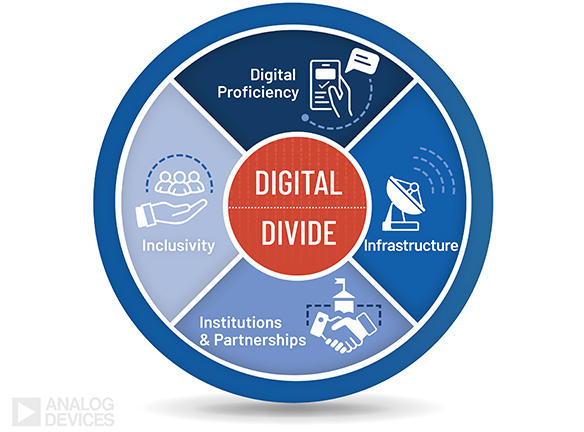In today’s fast-paced digital world, access to technology is no longer a luxury—it’s a necessity. Whether it’s for education, work, healthcare, or social connectivity, the internet and digital devices play a crucial role in modern society. However, not everyone has equal access to these technological advancements. This gap, commonly referred to as the “digital divide,” has significant economic, social, and educational implications.
The digital divide isn’t just about internet access; it extends to digital literacy, the availability of digital devices, and the ability to use technology effectively. While technological advancements have connected billions of people worldwide, millions still struggle with limited or no access. This article explores the causes of the digital divide, its effects, and potential solutions to bridge this technological gap.
Understanding the Digital Divide
Definition and Scope
The term “digital divide” refers to the gap between individuals, households, businesses, and geographic regions that have access to modern information and communication technology (ICT) and those that do not. This disparity can exist on various levels, including access to high-speed internet, digital literacy, and the affordability of devices such as smartphones, tablets, and computers.
The digital divide can be categorized into three main types:
- Access Divide: The difference between those who have internet access and those who do not.
- Usage Divide: The disparity in digital skills and literacy.
- Quality Divide: The variation in the quality of internet access, speed, and reliability.
Causes of the Digital Divide
Several factors contribute to the digital divide, including socioeconomic status, geographical location, education level, and age. Some of the main causes include:
Economic Barriers: The cost of internet services, devices, and software can be prohibitively high for low-income individuals and families.
Geographical Limitations: Rural and remote areas often lack the infrastructure for high-speed internet.
Educational Gaps: A lack of digital literacy and technical skills prevents many people from using technology effectively.
Government and Policy Issues: Inadequate policies and regulations can hinder technology accessibility and affordability.
Language and Cultural Barriers: Limited access to content in native languages or culturally relevant digital resources can create obstacles for certain communities.
The Impact of the Digital Divide
Education and Learning Opportunities
One of the most significant effects of the digital divide is its impact on education. Students without internet access or digital devices are at a severe disadvantage, especially in an era where online learning is becoming the norm. The COVID-19 pandemic highlighted this issue, as schools worldwide shifted to online education, leaving millions of students behind due to a lack of digital resources.
Economic and Employment Disparities
The digital divide also affects job opportunities and economic growth. Many jobs today require digital skills, from basic computer knowledge to advanced programming and data analysis. Those without digital literacy face limited job prospects, reinforcing cycles of poverty and unemployment. Additionally, businesses without reliable internet access struggle to compete in the digital economy, further widening the economic gap.
Social and Healthcare Inequalities
Social connectivity is another crucial aspect of the digital divide. Individuals without internet access may feel isolated, as digital platforms have become the primary means of communication. Furthermore, telehealth services, which have grown significantly in recent years, are inaccessible to those without the necessary technology, limiting their access to medical care.
Strategies to Bridge the Digital Divide
Expanding Infrastructure and Connectivity
Governments and private sectors must invest in expanding broadband infrastructure, especially in rural and underserved areas. Initiatives like public Wi-Fi hotspots, subsidized broadband programs, and partnerships with tech companies can significantly improve internet access.
Affordable Technology and Internet Services
Making digital devices and internet services more affordable is crucial in reducing the digital divide. Subsidized programs for low-income families, refurbished device distribution, and competitive pricing models can help make technology accessible to all.
Enhancing Digital Literacy and Skills
Education plays a pivotal role in closing the digital gap. Schools, libraries, and community centers should offer digital literacy programs that teach individuals how to use the internet safely and efficiently. Empowering people with digital skills can improve their job prospects, financial literacy, and overall quality of life.
Public-Private Partnerships
Collaboration between governments, tech companies, and non-profit organizations can accelerate efforts to bridge the digital divide. Companies like Google, Microsoft, and Facebook have initiated projects to provide free or low-cost internet access in developing regions. More such partnerships can lead to widespread improvements in digital inclusion.
Case Studies: Success Stories in Closing the Digital Divide

The United States’ Rural Broadband Initiative
The U.S. government has launched several initiatives to improve broadband access in rural areas. Programs like the FCC’s “Connect America Fund” and “Rural Digital Opportunity Fund” have provided funding for expanding high-speed internet in underserved communities.
India’s Digital India Campaign
India has made significant strides in bridging the digital divide through its “Digital India” initiative. By increasing mobile network coverage, promoting digital literacy, and implementing financial technology solutions, India has expanded internet access to millions of previously disconnected citizens.
Africa’s Mobile Revolution
In Africa, mobile technology has played a vital role in reducing the digital divide. With limited broadband infrastructure, mobile networks have provided internet access to remote areas, allowing people to participate in the digital economy through mobile banking and e-commerce.
The Future of Digital Inclusion
While progress is being made, there is still a long way to go in achieving complete digital inclusion. Emerging technologies like satellite internet (e.g., Starlink), 5G expansion, and AI-driven educational tools have the potential to further bridge the digital gap. Governments, businesses, and individuals must continue to work together to create a more inclusive digital landscape.
By investing in digital accessibility, improving affordability, and promoting digital literacy, the world can move toward a future where technology is accessible to all, regardless of location or socioeconomic background. The fight against the digital divide is not just about connectivity—it’s about creating opportunities for everyone to thrive in the digital era.
